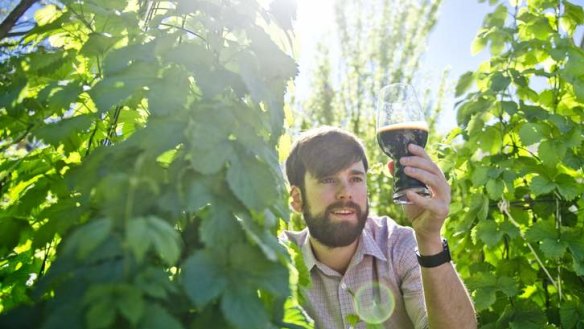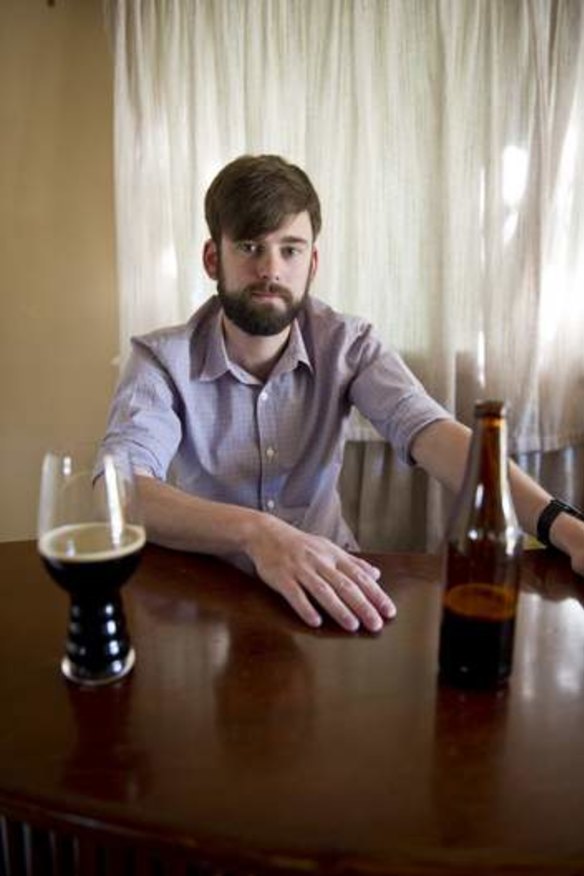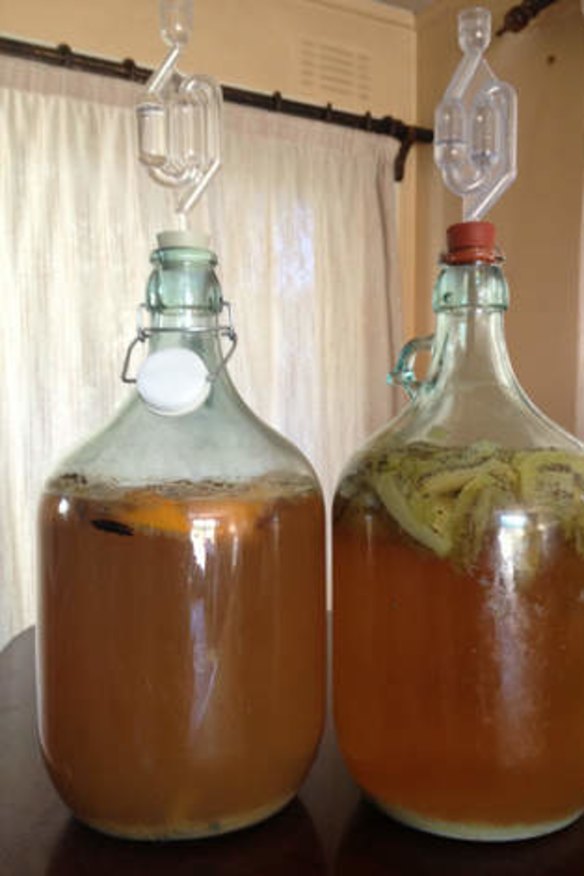All goes into the brewpot
When inspiration strikes, Kevin Hingston gets to work and makes another unique beer, writes <b>Kirsten Lawson</b>.

For Kevin Hingston, brewing seems partly a matter of wandering the garden to see what's growing. Quince? Why not make a beer of it? Lemons? Let's throw them in a fermenter as well.
There are hops out there also, in the small, unkempt backyard of Hingston's tiny, original Lyons cottage. It was the hops that got him started. He had an interest in gardening and a friend who grew hops, so he grew hops as a gardening project - his two plants went from ground to more than three metres in just eight weeks. And once you have a plant like that in the backyard, it doesn't take long before you turn to brewing.
Hingston, whose day job is in IT with the public service, is a hobby brewer with considerable success. Last month he was named champion brewer in the Canberra home brewing awards. Nine of his beers qualified for the national champs, held in Canberra last weekend, November 1 and 2. He took first place with his German wheat beer, which was also runner-up for champion beer of the show.

Among his entries were his second attempt at a quince beer. The first time he made the mistake of putting quince in the initial boil and as anyone who has made quince jam or paste will know, it's a fruit with loads of pectin.
"There was a very slight but noticeable gelatinous quality to the beer," he says.
This year, he added the fruit after the primary fermentation of two beers - a 50:50 wheat and barley beer called hefeweizen, and a Belgian-style sour ale called lambic, using about two kilograms of fruit for 15 litres of beer. The quince gives a subtle pear-like flavour, quite unlike the strength of a cherry or raspberry beer.
Generally people who say 'I don't drink beer, I don't like beer', are basing it on a small range.
The hefeweizen won the speciality category in the Canberra beer awards, a category that covers fruit beers, wood-aged beers, beers that don't fit anywhere else, or as he describes them, "crazy beers".
Among his other crazy beers is a kiwifruit brew he has at the moment in a demijohn (another demijohn holds mead, the honey-based drink). And a "pea porter", which he says was a cause of some teasing at the brew club.
For the pea porter (in our photograph), he uses peas to provide some of the starches, substituting some of the barley with dried soup peas (three kilograms of grain and two kilograms of peas in 20 kilograms of water). "It doesn't end up tasting like pea, but

there's this texture to the head of the beer that's not unlike a pea soup," he says, with a velvety creaminess to the mouthfeel.
There are three main drivers of flavour in beer, he says - yeast, malt and hops. You're aiming to focus on one, rather than all three to avoid a confused tasting result.
And as with cooking, the fresher your ingredients the better. Hingston says it's difficult to make a craft beer using malt extract. Instead, it's best to buy the whole grain - barley or wheat - which you get from the brew shop. You can also buy cracked grain, but you need to use it fairly quickly. Hingston prefers to "crack" or mill his own grain, on a mill he has set up in the garage. The grain comes malted, which means it has been sprayed with water to start germination, then kilned to varying levels of darkness to stop germination and give the biscuity flavours.
As for hops, it appears it's not necessary to go so far as to grow your own. Hingston has been growing them for three seasons and says he is yet to get sufficient quantities to use in beer, although he's hopeful this year. He's growing two American hops - chinook and cascade, which are high in bitterness. They're the hops, as he puts it, that "really brought obnoxious American beers out into the open". This might sound like a criticism, but it isn't. They're styles that Hingston really likes - India pale ale and American pale ale, up-front, unsubtle beers.
Meantime, he buys hops that come pelletised. They also come with a measure of how much bitterness they will add, so you know what effect it's going to have. You control the bitterness, flavour and aroma of hops by adding them at different stages of the boil - as long as 60 minutes in the boil for less flavour and more bitterness, and right at the end for flavour and aroma.
Despite these complicated sounding variables, Hingston is anxious not to give the impression that home brewing is complex or expensive. You don't need to go to the lengths that he has, of setting up his own grain mill, growing his own hops and spending $3500 on a Braumeister brewing kettle.
You can simply buy a $100 urn and a $30 bag (a favourite for local brewers is Brew Your Own in Kambah), and even just do it on the stove top.
Once the grain is "cracked", or roughly milled, it goes into the bag, and into the brew pot with water. It's heated to 60-70 degrees, the point when the enzymes break down the starches and turn them into sugars, for 60 to 90 minutes. This gives you a "wort", which you then boil, adding hops when you're ready, for another 60 to 90 minutes. Then you chill it and it's ready for the ferment, when you add whatever yeast you choose to turn the sugars into alcohol.
Beer is not a long ferment, like wine, but is ready to drink in between one and three weeks - longer and colder, at 6-12 degrees for lagers, and shorter and warmer, 18-20 degrees, for standard ales. You know it's ready when your hydrometer, which measures the amount of sugar, is steady for three days, indicating the yeast has done its job (also giving you reassurance you're not going to create a "bottle bomb" as the ferment continues in the bottle).
Temperature is where many home brewers go wrong, Hingston says, throwing their beer in the cupboard and leaving it for a month to see what happens. But with variations in temperature, yeasts can produce unappealing flavours - green apple or buttery popcorn, which might sound good but are frowned on in beer making, or sulphur, garden hose and bandaid, more obviously flavours to avoid.
So along with your urn and your bag, you should buy a control gadget to keep the temperature stable. Hingston keeps his beer in a chest freezer with a heat mat, and temperature controller.
Right now, he has an American wheat ale bubbling away at 18 degrees, and another intriguing drink, the one using lemons from his tree. He's making "hard", or alcoholic, lemonade. For this, he boiled lemon juice, water and dextrose and added a wine yeast. The result is a light, refreshing, simple drink at 4.5 per cent alcohol.
Lemonade is good to have on hand for non-beer drinkers, he says, though he believes there is a beer to suit everyone's tastes. While beer tends to be "a pretty gendered alcoholic drink", it shouldn't be, he says. He has converted his partner, Jing-Ling Chua, an exhibits designer at the National Gallery, to drink beer through his dark beers.
"So many people have a perception of what beer tastes like. They think of Carlton, they think of VB. They are beers and they have a place in our world, but there's so much more. Generally people who say 'I don't drink beer, I don't like beer', are basing it on a small range."
So taken is he with his journey into the world of homebrew, that Hingston has rarely brewed the same beer twice. He is always experimenting with new flavours and ingredients, and making beers with alcohol contents that vary from 3.5 per cent to 9.5 per cent.
He might only have been brewing for two years, but Hingston has embraced this hobby with a passion. He is now on the committee of the local brew club, and he's training to become a beer judge.
"I kind of just became quite singular about it," he says. "I take it quite seriously."
He says he joined the Canberra Brewers last year at a peak time. It had more than 100 members then and continued to grow, with 140 members now, and the city's place in the national scene cemented by the recent announcement that it will host the national homebrewers' conference next year, its first year outside Melbourne.
He attributes local interest partly to the size of the city - perfect for one strong brew club, and to the limited craft beer bar culture here - there are good commercial craft brewers here, but not many. "You have to make your own fun in that regard - we're filling the gap ourselves in a way."
>> Canberrans took first place in four of the 18 categories at the national awards: Hingston with his wheat beer; Adam Langan with his American pale ale; Mark Bilbrough with his brown ale; and Matt McDonald, Bruce Arnold and Gareth Prescott with their oak-aged Flanders red ale. The champion beer was a Californian Common made by Imants Vitolins, of Victoria. And champion brewer was Adam Beauchamp, of South Australia.
